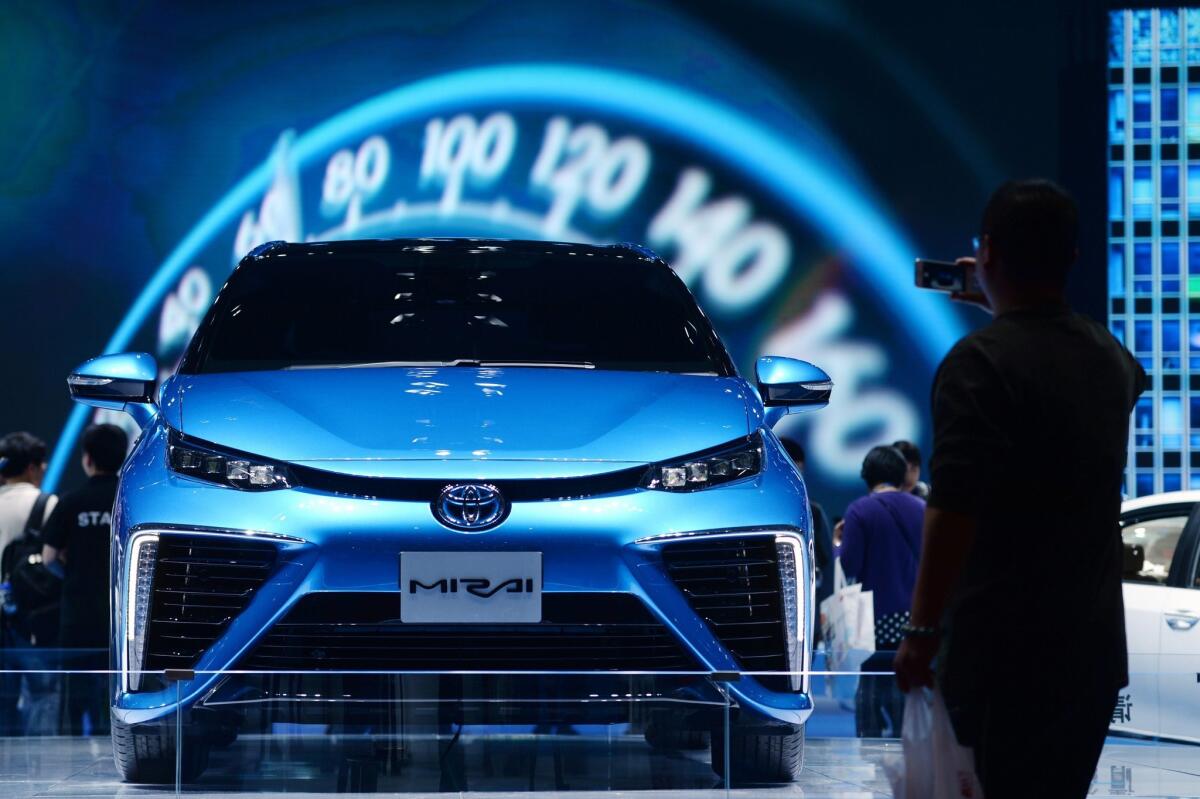With hydrogen fuel station, ARCO and La Cañada look to the Mirai

A man takes a photo in front of a Toyota Mirai during the 16th Shanghai International Automobile Industry Exhibition in Shanghai on April 22, 2015. La Cañada Flintridge’s first hydrogen cell station at the Foothill Boulevard ARCO station could soon be up and running, just as Toyota readies plans to roll out its first line of the hydrogen-powered vehicles in October.
- Share via
The city’s first hydrogen fuel cell station at the Foothill Boulevard ARCO station could soon be up and running, as installers iron out the final aesthetic details with the Design Commission and await building permit approval.
Installation of the one-pump refueling station could be completed within the next few months, according to Irvine start-up company FirstElement Fuel, which signed a 10-year lease with the Arco station owner to operate on a portion of the property.
Its unveiling will come not a moment too soon, says FirstElement chief development officer Shane Stephens, as Toyota readies plans to roll out its first line of hydrogen-powered vehicles in October.
“The first public lease of a fuel cell vehicle was in 2003. What’s happening now is a transition to commercialization,” Stephens said. “We’re creating that retail interface with the customers.”
The company is working with a $27.6-million grant from the California Energy Commission as well backing from automakers Toyota and Honda to install 19 retail fuel cell stations across the state in 2015. The La Cañada Flintridge station will be among the first round of pumps to offer the alternative fuel directly to consumers, Stephens said.
FirstElement’s plans are part of a wider effort being co-funded by the Energy Commission, which hopes to help create a network of stations that will allow motorists to fuel up and travel practically anywhere in the state.
In 2012, Gov. Jerry Brown issued an executive order to place 1.5 million zero-emission vehicles on California roads by 2025. Now agencies are partnering with companies like FirstElement to establish a marketplace and infrastructure where hydrogen-powered vehicles can proliferate.
Last Thursday, Stephens and chief executive Joel Ewanick, a former Hyundai and General Motors marketing executive, met with La Cañada’s design commissioners to finalize design plans for a fuel dispenser and canopy, which will operate on an 800-square-foot corner of the ARCO lot. Ewanick explained the company hopes to employ a hands-on approach with the station once it’s built.
“This is going to be a big deal,” Ewanick told commissioners at the meeting.
In October, Toyota plans to release the Mirai — the Japanese word for “future” — for the American market. The vehicle takes in air through the front grill and directs it to a fuel cell stack, where the oxygen chemically reacts with the stored hydrogen to create electricity. The by-product of the process is water, the Mirai’s only emission.
The vehicle can travel about 300 miles in between five-minute fueling stops. On its website, Toyota calls the Mirai a “turning point in automotive history.”
Pete Smith, co-owner and general manager of Bob Smith Toyota in La Crescenta, agrees. Although his dealership was not individually selected by the automaker for the initial unveiling of the Mirai, Smith believes the rollout is an important event.
“As a Toyota dealer, I’m excited about the technology,” Smith said, predicting the automaker’s release will be slow and steady. “There are people who say Toyota’s going down the wrong track, that electric cars are better, But I wouldn’t bet against Toyota.”
Stephens admits some are initially dubious about the safety of bringing the highly combustible gas into a retail space but assures FirstElement stations are equipped with monitoring and detection devices designed to prevent leakage.
Additionally, FirstElement guarantees at least 33% of the hydrogen fuel it uses comes from renewable sources, in accordance with California standards, as opposed to being derived from fossil fuels like coal or natural gas.
--
Sara Cardine, sara.cardine@latimes.com
Twitter: @SaraCardine
